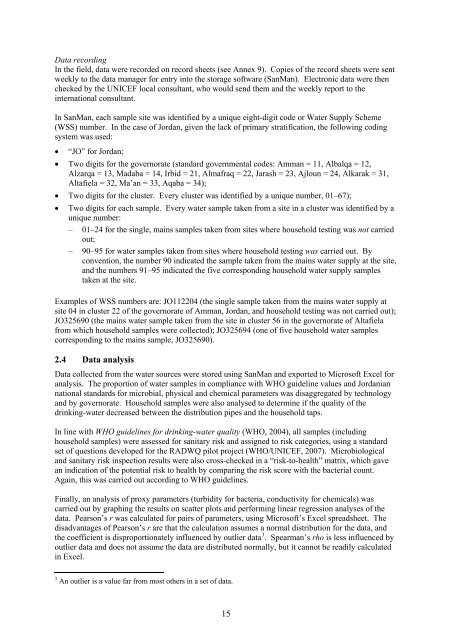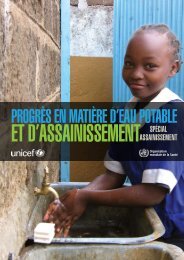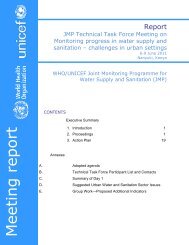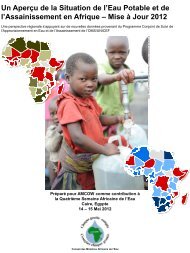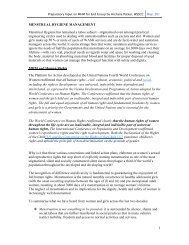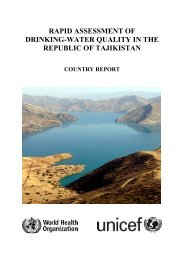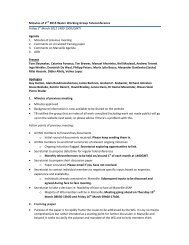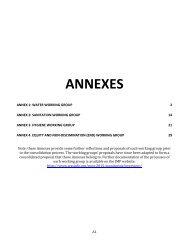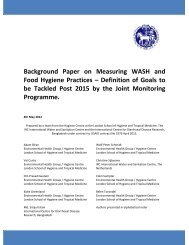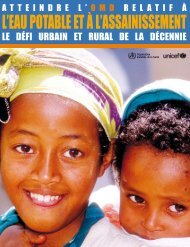Rapid assessment of drinking-water quality in the - WHO/UNICEF ...
Rapid assessment of drinking-water quality in the - WHO/UNICEF ...
Rapid assessment of drinking-water quality in the - WHO/UNICEF ...
Create successful ePaper yourself
Turn your PDF publications into a flip-book with our unique Google optimized e-Paper software.
Data record<strong>in</strong>g<br />
In <strong>the</strong> field, data were recorded on record sheets (see Annex 9). Copies <strong>of</strong> <strong>the</strong> record sheets were sent<br />
weekly to <strong>the</strong> data manager for entry <strong>in</strong>to <strong>the</strong> storage s<strong>of</strong>tware (SanMan). Electronic data were <strong>the</strong>n<br />
checked by <strong>the</strong> <strong>UNICEF</strong> local consultant, who would send <strong>the</strong>m and <strong>the</strong> weekly report to <strong>the</strong><br />
<strong>in</strong>ternational consultant.<br />
In SanMan, each sample site was identified by a unique eight-digit code or Water Supply Scheme<br />
(WSS) number. In <strong>the</strong> case <strong>of</strong> Jordan, given <strong>the</strong> lack <strong>of</strong> primary stratification, <strong>the</strong> follow<strong>in</strong>g cod<strong>in</strong>g<br />
system was used:<br />
“JO” for Jordan;<br />
Two digits for <strong>the</strong> governorate (standard governmental codes: Amman = 11, Albalqa = 12,<br />
Alzarqa = 13, Madaba = 14, Irbid = 21, Almafraq = 22, Jarash = 23, Ajloun = 24, Alkarak = 31,<br />
Altafiela = 32, Ma’an = 33, Aqaba = 34);<br />
Two digits for <strong>the</strong> cluster. Every cluster was identified by a unique number, 01–67);<br />
Two digits for each sample. Every <strong>water</strong> sample taken from a site <strong>in</strong> a cluster was identified by a<br />
unique number:<br />
– 01–24 for <strong>the</strong> s<strong>in</strong>gle, ma<strong>in</strong>s samples taken from sites where household test<strong>in</strong>g was not carried<br />
out;<br />
– 90–95 for <strong>water</strong> samples taken from sites where household test<strong>in</strong>g was carried out. By<br />
convention, <strong>the</strong> number 90 <strong>in</strong>dicated <strong>the</strong> sample taken from <strong>the</strong> ma<strong>in</strong>s <strong>water</strong> supply at <strong>the</strong> site,<br />
and <strong>the</strong> numbers 91–95 <strong>in</strong>dicated <strong>the</strong> five correspond<strong>in</strong>g household <strong>water</strong> supply samples<br />
taken at <strong>the</strong> site.<br />
Examples <strong>of</strong> WSS numbers are: JO112204 (<strong>the</strong> s<strong>in</strong>gle sample taken from <strong>the</strong> ma<strong>in</strong>s <strong>water</strong> supply at<br />
site 04 <strong>in</strong> cluster 22 <strong>of</strong> <strong>the</strong> governorate <strong>of</strong> Amman, Jordan, and household test<strong>in</strong>g was not carried out);<br />
JO325690 (<strong>the</strong> ma<strong>in</strong>s <strong>water</strong> sample taken from <strong>the</strong> site <strong>in</strong> cluster 56 <strong>in</strong> <strong>the</strong> governorate <strong>of</strong> Altafiela<br />
from which household samples were collected); JO325694 (one <strong>of</strong> five household <strong>water</strong> samples<br />
correspond<strong>in</strong>g to <strong>the</strong> ma<strong>in</strong>s sample, JO325690).<br />
2.4 Data analysis<br />
Data collected from <strong>the</strong> <strong>water</strong> sources were stored us<strong>in</strong>g SanMan and exported to Micros<strong>of</strong>t Excel for<br />
analysis. The proportion <strong>of</strong> <strong>water</strong> samples <strong>in</strong> compliance with <strong>WHO</strong> guidel<strong>in</strong>e values and Jordanian<br />
national standards for microbial, physical and chemical parameters was disaggregated by technology<br />
and by governorate. Household samples were also analysed to determ<strong>in</strong>e if <strong>the</strong> <strong>quality</strong> <strong>of</strong> <strong>the</strong><br />
<strong>dr<strong>in</strong>k<strong>in</strong>g</strong>-<strong>water</strong> decreased between <strong>the</strong> distribution pipes and <strong>the</strong> household taps.<br />
In l<strong>in</strong>e with <strong>WHO</strong> guidel<strong>in</strong>es for <strong>dr<strong>in</strong>k<strong>in</strong>g</strong>-<strong>water</strong> <strong>quality</strong> (<strong>WHO</strong>, 2004), all samples (<strong>in</strong>clud<strong>in</strong>g<br />
household samples) were assessed for sanitary risk and assigned to risk categories, us<strong>in</strong>g a standard<br />
set <strong>of</strong> questions developed for <strong>the</strong> RADWQ pilot project (<strong>WHO</strong>/<strong>UNICEF</strong>, 2007). Microbiological<br />
and sanitary risk <strong>in</strong>spection results were also cross-checked <strong>in</strong> a “risk-to-health” matrix, which gave<br />
an <strong>in</strong>dication <strong>of</strong> <strong>the</strong> potential risk to health by compar<strong>in</strong>g <strong>the</strong> risk score with <strong>the</strong> bacterial count.<br />
Aga<strong>in</strong>, this was carried out accord<strong>in</strong>g to <strong>WHO</strong> guidel<strong>in</strong>es.<br />
F<strong>in</strong>ally, an analysis <strong>of</strong> proxy parameters (turbidity for bacteria, conductivity for chemicals) was<br />
carried out by graph<strong>in</strong>g <strong>the</strong> results on scatter plots and perform<strong>in</strong>g l<strong>in</strong>ear regression analyses <strong>of</strong> <strong>the</strong><br />
data. Pearson’s r was calculated for pairs <strong>of</strong> parameters, us<strong>in</strong>g Micros<strong>of</strong>t’s Excel spreadsheet. The<br />
disadvantages <strong>of</strong> Pearson’s r are that <strong>the</strong> calculation assumes a normal distribution for <strong>the</strong> data, and<br />
<strong>the</strong> coefficient is disproportionately <strong>in</strong>fluenced by outlier data 3 . Spearman’s rho is less <strong>in</strong>fluenced by<br />
outlier data and does not assume <strong>the</strong> data are distributed normally, but it cannot be readily calculated<br />
<strong>in</strong> Excel.<br />
3 An outlier is a value far from most o<strong>the</strong>rs <strong>in</strong> a set <strong>of</strong> data.<br />
15


